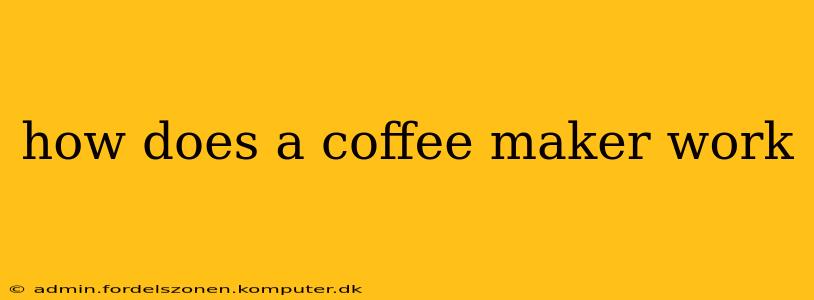Coffee makers, from the simplest pour-over to the most sophisticated espresso machine, all share a fundamental principle: extracting flavorful compounds from coffee grounds using hot water. However, the methods and mechanisms vary significantly, impacting the final brew's characteristics. This guide will delve into the workings of several common coffee maker types, explaining the process step-by-step.
The Basic Principles of Coffee Brewing
Before we dive into specifics, let's understand the core process:
-
Grinding: Coffee beans are ground to expose their surface area, maximizing contact with hot water. The grind size significantly affects extraction; coarser grinds yield weaker brews, while finer grinds produce stronger, potentially bitter ones.
-
Water Heating: Water is heated to an optimal temperature, typically between 195-205°F (90-96°C). Water that's too hot can scorch the grounds, resulting in a bitter taste, while water that's too cool will under-extract, producing a weak and sour brew.
-
Extraction: Hot water is brought into contact with the coffee grounds, dissolving the desirable oils, acids, and other compounds that contribute to coffee's flavor and aroma. This is where the magic happens! The time and temperature of this contact significantly impact the final product.
-
Filtration/Separation: The brewed coffee is separated from the spent coffee grounds, typically using a filter paper or a fine mesh.
Different Types of Coffee Makers and How They Work
Here’s a breakdown of how different coffee makers function:
1. Automatic Drip Coffee Makers:
These are the most common type. They typically consist of a water reservoir, a heating element, a filter basket, and a carafe.
- Process: Water is heated and pumped through a filter basket containing ground coffee. Gravity and the pressure from the water column draw the hot water through the grounds, extracting the coffee. The brewed coffee drips into a carafe below.
2. Pour-Over Coffee Makers:
These manual brewers offer more control over the brewing process.
- Process: Ground coffee is placed in a filter, usually paper, situated over a carafe or mug. Hot water is poured slowly over the grounds, allowing for even saturation and extraction. The speed and technique of pouring significantly affect the final taste.
3. French Press:
A classic and simple method that produces a full-bodied brew.
- Process: Coarsely ground coffee is steeped in hot water within a cylindrical vessel fitted with a mesh filter. After steeping, the mesh filter is pressed down, separating the grounds from the brewed coffee.
4. Espresso Machines:
These high-pressure machines create a concentrated coffee.
- Process: Finely ground coffee is compressed into a "puck" within a portafilter. Hot water is forced through the puck under high pressure (typically 9 bars), producing a rich, concentrated shot of espresso.
Frequently Asked Questions (FAQs)
What is the best temperature for brewing coffee?
The ideal temperature range is between 195-205°F (90-96°C). This range allows for optimal extraction without scorching the grounds.
What kind of coffee maker is best for beginners?
Automatic drip coffee makers are generally the easiest to use and maintain for beginners. They require minimal skill and provide consistent results.
How important is the grind size?
Grind size is crucial! Too fine a grind will lead to over-extraction and bitterness, while too coarse a grind results in under-extraction and a weak brew. Match the grind size to your brewing method.
How do I clean my coffee maker?
Cleaning methods vary depending on the type of coffee maker. Regularly rinsing the carafe and cleaning the filter basket is essential. Consult your coffee maker's manual for specific cleaning instructions. Descaling is also important to remove mineral deposits that can affect the taste and longevity of your machine.
Can I use any type of water to brew coffee?
While tap water works in a pinch, filtered water is generally recommended for the best-tasting coffee. Tap water can contain minerals and impurities that can affect the flavor.
By understanding the basic principles and the variations in different coffee maker types, you can appreciate the artistry and science behind your daily cup of coffee. Experiment with different methods and find what works best for you and your taste preferences.
